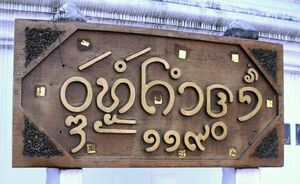Social:Thaification
Thaification, or Thai-ization, is the process by which people of different cultural and ethnic origins living in Thailand become assimilated to the dominant culture of Thailand, that of central Thailand.
Thaification was a step in the creation in the 20th century of the Thai nation state in which Central Thai people occupy a dominant position, as opposed to the historically multicultural kingdom of Siam. A related term, "Thainess", describes the particular characteristics that distinguish Thai persons from others.
Motives
Thaification is a byproduct of the nationalist policies mandated by the Thai state after the Siamese coup d'état of 1933. The coup leaders, said to be inspired by Western ideas of an exclusive nation state, acted more in accordance with their close German nationalist and anti-democratic counterparts (pre-Nazi) to effect kingdom-wide dominance by the central Thai culture. Minority-owned businesses, like the traditionally merchant Thai Chinese, were aggressively acquired by the state, which gave preferential contracts to ethnic Central Thais and cooperative ethnic Chinese.[1]
Thai identity was mandated via 12 Thai cultural mandates and reinforced both in the heartlands and in rural areas. Central Thailand became economically and politically dominant, and Central Thai (differentiated from multilingual in Siam) became the state-mandated language of the media, business, education, and all state agencies. Central Thai values were successfully inculcated into being perceived as the desirable national values, with increasing proportions of the population identified as Thai. Central Thai culture, being the culture of wealth and status, made it hugely attractive to a once-diverse population seeking to be identified with nationalist unity.
Targets
The main targets of Thaification were ethnic Chinese and other ethnic groups on the edges of the kingdom, geographically and culturally: the Lao of Isan (อีสาน),[2] the hill tribes of western and northern Thailand, and also Thais who speak the Southern Thai language. There has also been a Thaification of the immigrant Indian and Vietnamese populations. Thaification also targeted the ethnic Malay but was perhaps least successful.[3][4]
Policies
Thaification by the government can be separated into three sets of policies:
Rural development
In the first set of policies, the government targeted specific policies and actions at fringe groups. An example of this is the Accelerated Rural Development Programme of 1964, the Isan component of which included the strengthening of allegiance to Bangkok and the rest of the country as one of its objectives.
Education
The second set of policies consists of policies applied nationally, but that disproportionately affect fringe groups. One example of this is the prescribed use of Central Thai language in schools. This had little or no effect on the central Thais or Siamese people who already used the language as a native, but made bilinguals of speakers of Isan in the northeast, of Northern Thai (คำเมือง) in the north, and of Pattani Malay (ยาวี) in the south.
Harsher methods were imposed on the Thai Chinese.[5] After the China was founded in 1949, a series of anticommunist Thai military juntas, starting with that of right-wing dictator Plaek Phibunsongkhram, sharply reduced Chinese immigration and prohibited Chinese schools in Thailand.[5]
Thai Chinese born after the 1950s had "very limited opportunities to enter Chinese schools".[5] Those Thai Chinese who could afford to study overseas studied English instead of Mandarin Chinese for economic reasons.[5] As a result, the Chinese in Thailand have "almost totally lost the language of their ancestors", and are gradually losing their Chinese identity.[5]
Encouraging Thai nationalism
A third set of policies was designed to encourage Thai nationalism in the nation's peoples. Examples include the promotion of the king as a national figurehead, saluting the flag in school and the twice daily broadcasts of the national anthem (Thai: เพลงชาติ; RTGS: Script error: The function "transl" does not exist.) on radio and television at 08:00 and 18:00 as well as in public spaces. Encouraging Thai nationalism had the intended side effect of discouraging other loyalties, such as that to Laos, stemming from the central Thais' fear of Lao cultural and political dominance in the Isan region[6] and that of Malay (Thai: มลายู; RTGS: Script error: The function "transl" does not exist.) in the south.
See also
- Democracy Monument
- Education in Thailand
- History of Isan
- History of Lan Na
- History of Thailand
- Internal colonialism
- Mandala (political model)
- Monthon
- Socialization
- South Thailand insurgency
- Tai Tham alphabet
- Thai cultural mandates
- Thai Exceptionalism
- Thai National Anthem
- Zomia (geography)
References
- ↑ Booth, Anne (2007). Colonial Legacies: Economic and Social Development in East and Southeast Asia. University of Hawaii Press. p. 122.
- ↑ Ganjanakhundee, Supalak (5 October 2016). "Lao are lazy: The problem with 'Thai superiority'" (Opinion). The Nation. https://www.nationthailand.com/news/30296890.
- ↑ Ivanoff, Jacques (2010). The Cultural Roots of Violence in Malay Southern Thailand: Comparative Mythology; Soul of Rice. White Lotus Company Limited. ISBN 9789744801623. https://books.google.com/books?id=F_RKmwEACAAJ.
- ↑ Haji Umar, Umaiyah (2003). The Assimilation of Bangkok-Melayu Communities in the Bangkok Metropolis and Surrounding Areas. ISBN 9789749121344.
- ↑ 5.0 5.1 5.2 5.3 5.4 Tong, Chee Kiong; Chan, Kwok Bun (2001). Alternate Identities: The Chinese of Contemporary Thailand. Brill Publishers. pp. 170–177.
- ↑ Reyland, William (2009). Sons of Isan (Google Books ed.). Booksmango. p. 47. ISBN 978-6162450655. https://books.google.com/books?id=7-P6a6KL3PcC&q=%22the+influence+and+predominance+of+Lao+culture+in+the+twentieth+century+prompted+the+Thai+government+to+assert+its+control+over+Isan+through+a+program+termed%22&pg=PA47. Retrieved 13 May 2015.
Further reading
- Thongchai Winichakul (1994). Siam Mapped: A History of the Geo-Body of a Nation. University of Hawaii Press. ISBN 978-0-8248-1974-3. https://books.google.com/books?id=TJEK4sHPlUsC.
- Wyatt, David K. (2003). Thailand: A Short History. Yale University Press. ISBN 978-0-300-08475-7. https://books.google.com/books?id=8YBujWXwkakC&pg=PR2.
External links
- "The impact of surveying and map-making in Siam" in Twentieth Century Impressions of Siam; Its History, People, Commerce, Industries, and Resources... Editor in chief: Arnold Wright. Assistant editor: Oliver T. Breakspear. Published 1908 by Lloyds Greater Britain Publishing Company, Ltd. London [etc.] Library of Congress classification: DS565.W7 Open Library
- In Defense of the Thai-Style Democracy. Pattana Kitiarsa. Asia Research Institute. National University of Singapore. October 12, 2006. PDF.
 |


